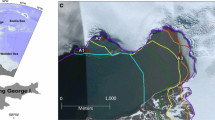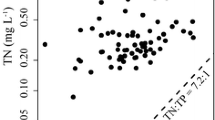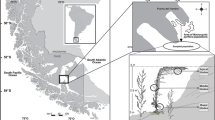Abstract
Light environment, community structure, pigments, and photophysiological properties of mat-forming phytobenthos were studied in four shallow Antarctic lakes in 2007 at maximum water depths of 1.7–2.5 m. All lakes were oligotrophic, and water transparencies were high, enabling 45–60% of photosynthetically active radiation (PAR, 400–700 nm) and 20–40% of ultraviolet radiation (300–400 nm) to reach the lake beds. Phytobenthic mats were dominated by cyanobacteria and green algae. Little PARL (500–700 nm) penetrated through the firm mat in the shallowest lake, while in the other lakes more (>20%) PARL got through the mats to the subsurface mat layers. Photochemical activities indicated almost no photoinhibition but low photosynthetic efficiency in all mat surface layers. Non-photochemical quenching was rarely detected, suggesting excess energy dissipation may not be efficient in the UV-rich environment. There was a positive correlation between photo-protective substances and incident radiation in the mats, and an inverse correlation between such substances and photochemical efficiency, suggesting that the phytobenthos survive by changing a light-protection/utilization balance. The communities under strong UV-B and PAR had firm mat textures and were characterized by high UV/photo-protective substance ratios that make them less transparent. Maximum relative electron transportation rates (rETRmax) and photochemical efficiencies, however, were low, possibly because the protective substances prevent efficient light usage. In contrast, communities under mild light were characterized by lower substance ratios and softer textures, while rETRmax values and photochemical efficiencies were greater. The phytobenthic mat surface seems to act as a filter for strong and harmful light, typically penetrating through the clear water of Antarctic lakes, and produces a milder light environment for the subsurface mat organisms.









Similar content being viewed by others
References
Ban A, Aikawa S, Hattori H, Sasaki H, Sampei M, Kudoh S, Fukuchi M, Satoh K, Kashino Y (2006) Comparative analysis of photosynthetic properties in ice algae and phytoplankton inhabiting Franklin Bay, the Canadian Arctic, with those in mesophilic diatoms during CASES 03–04. Polar Biosci 19:11–18
Demers S, Roy S, Gagnon R, Vignault C (1991) Rapid light-induced changes in cell fluorescence and in xanthophyll-cycle pigments of Alexandrium excavatum (Dinophyceae) and Thalassiosira pseudonana (Bacillariophyceae): a photo-protection mechanism. Mar Ecol Prog Ser 76:185–193
Demmig-Adams B (1990) Carotenoids and photoprotection in plants: a role for the xanthophylls zeaxanthin. Biochim Biophys Acta 1020:1–24
Ehling-Schulz M, Bilger W, Scherer AS (1997) UV-B-induced synthesis of photoprotective pigments and extracellular polysaccharides in the terrestrial cyanobacterium Nostoc commune. J Bacteriol 179:1940–1945
Eilers PHC, Peeters JCH (1988) A model for the relationship between light intensity and the rate of photosynthesis in phytoplankton. Ecol Modell 42:199–215
Ellis-Evans JC (1996) Microbial diversity and function in Antarctic freshwater ecosystems. Biodivers Conserv 5:1395–1431
Ellis-Evans JC, Laybourn-Parry J, Bayliss PR, Perriss SJ (1998) Physical, chemical and microbial community characteristics of lakes of the Larsemann Hills, continental Antarctica. Arch Hydrobiol 141:209–230
Falkowski PG, Raven JA (1997) Aquatic photosynthesis. Blackwell Science, Malden
Fernández-Valiente E, Camacho A, Rochera C, Rico E, Vincent WF, Quesada A (2007) Community structure and physiological characterization of microbial mats in Byers Peninsula, Livingston Island (South Shetland Islands, Antarctica). FEMS Microbiol Ecol 59(2):377–385
Fritsen CH, Priscu JC (1999) Seasonal change in the optical properties of the permanent ice cover on Lake Bonney, Antarctica: consequences for lake productivity and phytoplankton dynamics. Limnol Oceanogr 44(2):447–454
Garcia-Pichel F, Sherry ND, Castenholz RW (1992) Evidence for an ultra-violet sunscreen role of the extracellular pigment scytonemin in the terrestrial cyanobacterium Chlorogloeopsis sp. Photochem Photobiol 56:17–23
Goldman CR, Mason DT, Wood BJB (1963) Light injury and inhibition in Antarctic freshwater phytoplankton. Limnol Oceanogr 8:313–322
Hawes I, Schwarz A-M (1999) Photosynthesis in an extreme shade environment: benthic microbial mats from Lake Hoare, a permanently ice-covered Antarctic Lake. J Phycol 35:448–459
Heath CW (1988) Annual primary productivity of an Antarctic continental lake: phytoplankton and benthic algal mat production strategies. Hydrobiologia 165:77–87
Henshaw T, Laybourn-Parry J (2002) The annual patterns of photosynthesis in two large, freshwater, ultra-oligotrophic Antarctic lakes. Polar Biol 25:744–752
Heukelem LV, Thomas CS (2001) Computer-assisted high-performance liquid chromatography method development with applications to the isolation and analysis of phytoplankton pigments. J Chromatogr A 910:31–49
Hodgson DA, Vyverman W, Verleyen E, Sabbe K, Leavitt PR, Taton A, Squier AH, Keely BJ (2004) Environmental factors influencing the pigment composition of in situ benthic microbial communities in east Antarctic lakes. Aquat Microb Ecol 37:247–263
Howard-Williams C, Vincent WF (1989) Microbial communities in southern Victoria Land streams (Antarctica) I. Photosynthesis. Hydrobiologia 172:27–38
Imura S, Bando T, Saito S, Seto K, Kanda H (1999) Benthic moss pillars in Antarctic lakes. Polar Biol 22:137–140
Imura S, Bando T, Seto K, Ohtani S, Kudoh S, Kanda H (2003) Distribution of aquatic mosses in the Soya Coast region, East Antarctica. Polar Biosci 16:1–10
Jialal J, Norkus EP, Cristol L, Grundy SM (1991) β-carotene inhibits the oxidative modification of low-density lipoprotein. Biochem Biophys Acta 1086:134–138
Karsten U, Friedl T, Schumann R, Hoyer K, Lembcke S (2005) Mycosporine-like amino acids and phylogenies in green algae: Prasiola and its relatives from the Trebouxiophyceae (Chlorophyta). J Phycol 41:557–566
Kashino Y, Kudoh S (2003) Concerted response of xanthophylls-cycle pigments in a marine diatom, Chaetoceros gracillis, to the shift of light condition. Phycol Res 51:168–172
Kashino Y, Fujimoto K, Akamatsu A, Koike H, Satoh K, Kudoh S (1998) Photosynthetic pigment composition of ice algal and phytoplankton assemblages in early spring in Saroma Ko lagoon, Hokkaido, Japan. Proc NIPR Symp Polar Biol 11:22–32
Kashino Y, Kudoh S, Hayashi Y, Suzuki Y, Odate T, Hirawake T, Satoh K, Fukuchi M (2002) Strategies of phytoplankton to perform effective photosynthesis in North Water. Deep Sea Res II 49:5049–5061
Kudoh S, Tsuchiya Y, Ayukawa E, Imura S, Kanda H (2003a) Ecological studies of aquatic moss pillars in Antarctic lakes. 1. Macro structure and carbon, nitrogen and Chl a contents. Polar Biosci 16:11–22
Kudoh S, Watanabe K, Imura S (2003b) Ecological studies of aquatic moss pillars in Antarctic lakes. 2. Temperature and light environment at the moss habitat. Polar Biosci 16:23–32
Kudoh S, Kashino Y, Imura S (2003c) Ecological studies of aquatic moss pillars in Antarctic lakes. 3. Light responses and chilling and heat sensitivity of photosynthesis. Polar Biosci 16:33–42
Kudoh S, Imura S, Kashino Y (2003d) Xanthophyll cycle of ice algae on the sea ice bottom in Saroma Ko lagoon, Hokkaido, Japan. Polar Biosci 16:86–97
Lohr M, Wilhelm C (1999) Algae displaying the diadinoxanthin cycle also possess the violaxanthin cycle. Proc Natl Acad Sci USA 96:8784–8789
Matsumoto GI, Komori K, Enomoto A, Imura S, Takemura T, Ohyama Y, Kanda H (2006) Environmental changes in Syowa Station area of Antarctica during the last 2300 years inferred from organic components in lake sediment cores. Polar Biosci 19:51–62
McMinn A, Hegseth EN (2004) Quantum yield and photosynthetic parameters of marine microalgae from the southern Arctic Ocean, Svalbard. J Mar Biol Assoc UK 84:865–871
Miura H, Maemoku H, Igarashi A, Moriwaki K (1998) Late quaternary raised beach deposits and radiocarbon dates of marine fossils around Lützow-Holm Bay. Special map series of NIPR 6, National Institute of Polar Research, Tokyo
Morris DP, Zagarese H, Williamson CE, Balseiro EG, Hargreaves BR, Modenutti B, Moeller R, Queimalinos C (1995) The attenuation of solar UV radiation in lakes and the role of dissolved organic carbon. Limnol Oceanogr 40:1381–1391
Mueller DR, Vincent WF, Bonilla S, Laurion I (2005) Extremotrophs, extremophiles and broadband pigmentation strategies in a high arctic ice shelf ecosystem. FEMS Microbiol Ecol 53:73–87
Olaizola M, Roche JLA, Kolber Z, Falkowski PG (1994) Non-photochemical fluorescence quenching and the diadinoxanthin cycle in a marine diatom. Photosynth Res 41:275–282
Pfündel EE, Pan R-S, Dilley RA (1992) Inhibition of violaxanthin deep oxidation by ultraviolet-B radiation in isolated chloroplasts and intact leaves. Plant Physiol 98:1372–1380
Proteau PJ, Gerwick WH, Garcia-Pichel F, Castenholz R (1993) The structure of scytonemin, an ultraviolet sunscreen pigment from the sheaths of cyanobacteria. Experientia 49:825–829
Quesada A, Vincent WF (1997) Strategies of adaptation by Antarctic cyanobacteria to ultraviolet radiation. Eur J Phycol 32:335–342
Quesada A, Vincent WF, Lean DRS (1999) Community and pigment structure of Arctic cyanobacterial assemblages: the occurrence and distribution of UV-absorbing compounds. FEMS Microbiol Ecol 28:315–323
Quesada A, Fernandez-Valiente E, Hawes I, Howard-Williams C (2008) Benthic primary production in polar lakes and rivers. In: Vincent WF, Laybourn-Parry J (eds) Polar lakes and rivers. Oxford University Press, Oxford, pp 179–196
Roos JC, Vincent WF (1998) Temperature dependence of UV radiation effects on Antarctic cyanobacteria. J Phycol 34:118–125
Sabbe K, Hodgson DA, Verleyen E, Taton A, Wilmotte A, Vanhoutte K, Vyverman W (2004) Salinity, depth and the structure and composition of microbial mats in continental Antarctic lakes. Freshw Biol 49:296–319
Sakshaug E, Demers S, Yentch CM (1987) Thalassiosira oceanica and T. pseudonana: two different photoadaptational responses. Mar Ecol Prog Ser 41:275–282
Schreiber U, Bilger W, Neubauer C (1994) Chlorophyll fluorescence as a nonintrusive indicator for rapid assessment of in vivo photosynthesis. In: Schulze E-D, Caldwell MM (eds) Ecophysiology of photosynthesis. Springer, Berlin, pp 49–70
Simmons GM, Vestal JR, Wharton RA (1993) Environmental regulators of microbial activity in continental Antarctic lakes. In: Green WJ, Eriedmann EI (eds) Physical and biogeochemical processes in Antarctic Lakes. Antarctic Research Series, vol 59. American Geophysical Union, Washington, DC, pp 197–214
Squyres SW, Andersen DW, Nedell SS, Wharton RA (1991) Lake Hoare, Antarctica—sedimentation through a thick perennial ice cover. Sedimentology 38:363–379
Streb P, Feierabend J, Bligny R (1997) Resistance to photoinhibition of photosystem II and catalase and antioxidative protection in high mountain plants. Plant Cell Environ 20:1030–1040
Suh H-J, Lee H-W, Jung J (2003) Mycosporine glycine protects biological systems against photodynamic damage by quenching singlet oxygen with a high efficiency. Photochem Photobiol 78:109–113
Tanabe Y, Kudoh S, Imura S, Fukuchi M (2008) Phytoplankton blooms under dim and cold conditions in freshwater lakes of East Antarctica. Polar Biol 31:199–208
Tang EPY, Tremblay R, Vincent WF (1997) Cyanobacterial dominance of polar freshwater ecosystems: are high-latitude mat-formers adapted to low temperature? J Phycol 33:171–181
Telfer A, Rivas JDL, Barber J (1991) β-carotene within the isolated photosystem II reaction centre: photo-oxidation and irreversible bleaching of this chromophore by oxidised P680. Biochim Biophys Acta 1060:106–114
Vincent WF (1988) Microbial ecosystems of Antarctica. Cambridge University Press, Cambridge
Vincent WF, Quesada A (1994) Ultraviolet radiation effects on cyanobacteria: implications for Antarctic microbial ecosystems. Antarctic Res Ser 62:111–124
Vincent WF, Downes MT, Castenholz RW, Howard-Williams C (1993) Community structure and pigment organisation of cyanobacteria-dominated microbial mats in Antarctica. Eur J Phycol 28:213–221
Vincent WF, Rae R, Laurion I, Howard-Williams C, Priscu JC (1998) Transparency of Antarctic Ice-Covered Lakes to Solar UV Radiation. Limnol Oceanogr 43:618–624
Wharton RA, Parker BC, Simmons GM (1983) Distribution, species composition and morphology of algal mats in Antarctic Dry Valley lakes. Phycologia 22:355–365
Wildi B, Lütz C (1996) Antioxidant composition of selected high alpine plant species from different altitudes. Plant Cell Environ 19:138–146
Wynn-Williams DD (1990) Ecological aspects of Antarctic microbiology. In: Marshall KC (ed) Advances in microbial ecology, vol 11. Plenum Press, New York, pp 71–146
Zonneveld C (1998) Photoinhibition as affected by photoacclimation in phytoplankton: a model approach. J Theor Biol 193:115–123
Acknowledgments
We acknowledge all the members of the 48th Japanese Antarctic Research Expedition (JARE), especially its summer party leader Dr. T. Odate, for their support. We thank Ms A. Sugimoto, Dr T. Hoshino, and Dr D. Han for assistance with nutrient analysis and the field research. This study was carried out under the project named “Studies on climate processes and ecosystem dynamics in polar region”, sub-theme “Ecological studies on Antarctic terrestrial and lake environments” in the JARE-48th research projects.
Author information
Authors and Affiliations
Corresponding author
Electronic supplementary material
Below is the link to the electronic supplementary material.
Rights and permissions
About this article
Cite this article
Tanabe, Y., Ohtani, S., Kasamatsu, N. et al. Photophysiological responses of phytobenthic communities to the strong light and UV in Antarctic shallow lakes. Polar Biol 33, 85–100 (2010). https://doi.org/10.1007/s00300-009-0687-1
Received:
Revised:
Accepted:
Published:
Issue Date:
DOI: https://doi.org/10.1007/s00300-009-0687-1




